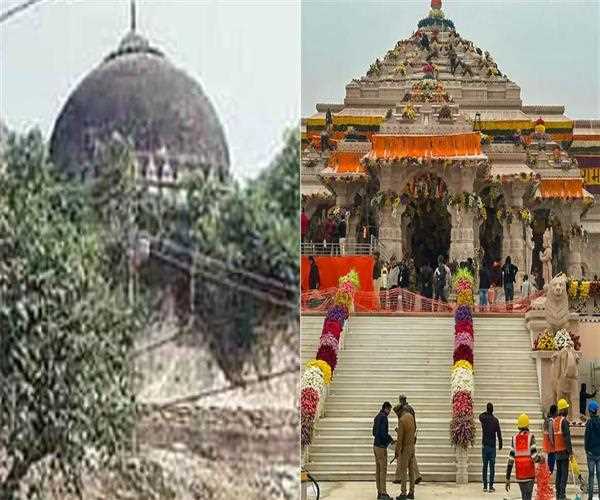
23-Jan-2024 , Updated on 1/23/2024 9:22:31 PM
Story of Ram Temple explained from 1528 to 2024 a struggle of 500 years
The story of Ayodhya Ram Mandir is not just a historical account but an epic that contains five centuries, growing religious dimensions and legal complexities along with political aims and communal unity. From the Babri Masjid constructed in 1528 till 22nd January, which was the grand Pran Prathistha ceremony of 2024, its journey a nation with its past; present, and future.
The Ram Mandir can be viewed as a living symbol of the Indian cultural mosaic in which this monumental batThe story of Babri Masjid began in 1528 when Mir Baqi, the commander to Mughal emperor Babur constructed a mosque that today is locally known as ‘Babri Masjid. The issue of the Ayodhya Ram Mandir can be taken back to 1853 when religious violence flared up over the location. The site was one of the focal points where Babur constructed it during his time, and later in history Nirmohis a Hindu sect claimed that it had been demolished as a mandir. In 1859, the British intervention brought about a subdivision of this spot where Muslims were allowed to partake in prayer on the mosque’s insides while Hindus used for outer court and it there laid the foundation seeds for destiny shaping.
Legal Storm: The Battle Begins (1949-1961)
The dispute thus developed a new turn in 1949 giving rise to legal petitions after the idols of Ram Lalla were discovered inside Babri Masjid. One petition asked for permission to worship of this deity and another demanded protection only mosque. The government's response was to close the site, allowing priests to perform daily rituals but denying worshippers access. This presented the beginning of a long legal battle over the ownership and fate for which part was fought. In 1961, a crucial occurrence took place when Muslims filed an appeal seeking the restoration of their ownership rights to the land that was in dispute.
Religious Renaissance: 1980s and Ram Mandir
The 1980s were purged with religious and political revival when a committee headed by the Vishva Hindu Parishad party (VHP) came out in search of freeing Sri Ram’s birthplace and building the Mandir. This made the construction of Ram Mandir official giving another twist to an age-old problem. In the year 1989, VHP commenced a significant move by starting the construction of Ram Mandir on land near Babri Masjid. Legal fights followed with a motion to move the mosque. LK Advani, the leader of Rath Yatra in 1990 galvanized public support for temple construction but also brought political wrangles leading to arrestment of Adv.
Demolition of Babri Masjid: A Turning Point (1992)
The starting of the Ayodhya Ram Mandir case was on December 6, 1992, when members from Shiv Sena, VHP, and BJP demolished the Babri Mosque by ‘Kar sevaks. This act of destruction thus spawned riots throughout the country, leading to massive killings and international opprobrium. The incident had an indelible mark on India’s socio-political landscape that further decided the path of the Ayodhya dispute.
Legal Validation: The Disputed Site Divided by Allahabad HC (2010)
The Archaeological Survey of India (ASI) was surveyed in 2003 at the disputed site where archaeologists found proof that there was an enormous Hindu complex located under the mosque. However, these results were challenged by Muslim organizations, which further increased the polemics on the historical perspective of this site. The legal battle made a stride in 2010 when the Allahabad High Court passed its verdict, dividing the contested land into three parts. The share of one-third was reserved for Ram Lalla represented by the Hindu Mahasabha, another portion fell to the Islamic Waqf Board and a third part remained with Nirmohi Akhara. This ruling led to further litigation, with the Hindu Mahasabha and Sunni Waqf Board appealing to the Supreme Court.
Supreme Court's Landmark Verdict: The Ram Temple Road (2019)
On November 9, 2019, the Supreme Court delivered a historic verdict ordering the transfer of a disputed land area of 3.77 acres to a trust for building Ram Janmabhoomi Mandir in the meantime, the court instructed the government to give an alternative five acres of land for a mosque’s construction on behalf of Sunni Waqf Board. This landmark judgment gave the legal justification for building the Ram Mandir.
Foundation Stone Laying and Pran Prathistha Ceremony
August 5, 2019, marked the end of our journey when Prime Minister Narendra Modi broke ground for the building of Ram Mandir. This symbolic moment signaled the end of a new era and finally put an end to years-long legal disputes, political scheming, and social upheaval. With this historical act, the inauguration of Ram Mandir in Ayodhya on January 23 this year was a momentous occasion leading up to consecration. Primer Minister Narendra Modi and top dignitaries led the ceremony to indicate that their dream has come true for millions of devotees.
Ram Mandir: Result of Faith, Struggle and Harmony
The Ayodhya Ram Mandir represents a religious icon, complicated legal system, political power struggles, and communal harmony in the woven tapestry of India’s past. From 1528 to the present day, a nation’s historical evolution from past events and its current and future aspirations is mirrored by an emerging process of change in which India witnesses its multifaceted cultural diversity prevailing on one single Ram Mandir. The battle for 500 years is described through the touching tale of persistence, desire, and collective desires that are stamped in the history of a country representing unity and beliefs.

Content writer
I am a content writter !
Join Our Newsletter
Subscribe to our newsletter to receive emails about new views posts, releases and updates.
Copyright 2010 - 2026 MindStick Software Pvt. Ltd. All Rights Reserved Privacy Policy | Terms & Conditions | Cookie Policy